
We had some free time on our recent trip to Los Angeles to visit family and we decided to reacquaint ourselves with the art and gardens of the Huntington. In 1913 Henry Huntington purchased a property of more than 500 acres that was then known as the “San Marino Ranch”, and went on to purchase other large tracts of land in the Pasadena and Los Angeles areas of Los Angeles County for urban and suburban development. The Huntington was founded in 1919 by Henry Huntington, a businessman who built a financial empire that included railroad companies, utilities, and real estate holdings in Southern California. Huntington was also a man of vision with a special interest in books, art, and gardens. During his lifetime, he amassed the core of one of the best research libraries in the world, established a lovely art collection, and created an array of botanical gardens with plants from a geographic range spanning the globe. These three distinct facets of The Huntington are linked by a commitment to research, education, and beauty. For qualified scholars, The Huntington is one of the largest and most complete research libraries in the United States in its fields of specialization. The Botanical Gardens are an ever-changing exhibition of color and a constant delight. Covering 120 acres, more than a dozen specialized gardens are arranged within a park-like landscape of rolling lawns. While the art collection is known for the Gainsborough “Blue Boy” there are many hidden gems in the collection.












Although we did not tour the gardens, we were able to see some unusual and beautiful plants, as you can see above. Of particular interest was the Caifornia poppy, the state flower and the Verbena bonariensis. The fuzzy yellow kangaroo paws are a hybrid from Australia that has become very popular in California. The exotic Chondropetalum is an evergreen perennial from the southern Cape of South Africa forms dense clumps of round, dark green stems with paper thin bands of brown. The mahogany stripes on the canes are actually protective sheaths that shield the new growth on its way up, node to node to node. The sheaths then split and curl away from the stem. The inside of the sheaths are shiny and the color of gold. The entire effect in even a small breeze is what appear to be flakes of pure gold reflecting the sun from a clump of reeds. It is a spectacular effect for any garden. We plan to go back to explore the gardens on a future trip.
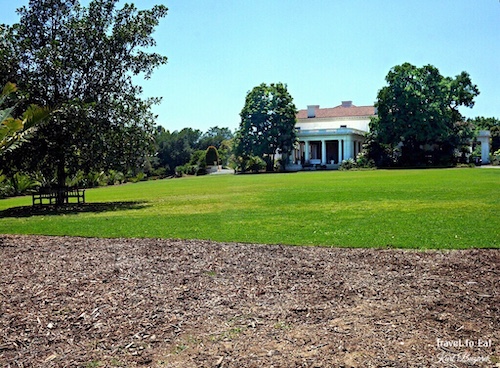


Huntington was one of the country’s most prominent collectors of rare books and manuscripts. In 1920 the library building was completed to house his outstanding collection. In 1919, Henry and Arabella Huntington signed the indenture that transferred their San Marino property and collections to a nonprofit educational trust, creating The Huntington Library, Art Collections, and Botanical Gardens, which hosts more than 500,000 visitors each year. Henry Huntington died in 1927, Arabella predeceased him by three years. There is not much to see in the library, unless you are a scholar, a few rare books are on display.

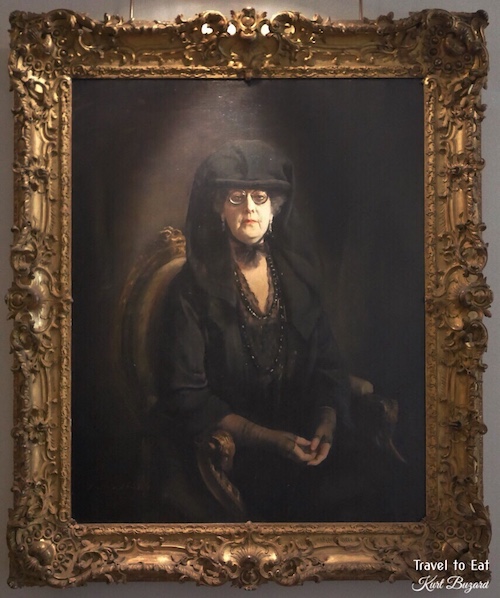
Henry E. Huntington was the nephew of Collis P. Huntington, one of The Big Four, the men instrumental in creating the Central Pacific Railroad (later called Southern Pacific), one of the two railroads that built the transcontinental railway in 1869. Huntington held several executive positions working alongside his uncle with the Southern Pacific Transportation Company. After Collis P. Huntington’s death, Henry E. Huntington assumed Collis Huntington’s leadership role with Newport News Shipbuilding and Drydock Company in Virginia, and married his widow Arabella Huntington. His divorce from his first wife, Mary Alice Prentice, birth sister of his Uncle Collis’ adopted daughter, in 1910 and marriage to Arabella in 1913 after Mary Alice’s death shocked San Francisco society, and prompted his move to Los Angeles.


Huntington’s interest in art was influenced in large part by his second wife, Arabella Huntington, (1851–1924), and with art experts to guide him, he benefited from a post-World War I European market that was “ready to sell almost anything”. Before his death in 1927, Huntington amassed “far and away the greatest group of 18th-century British portraits ever assembled by any one man”.

This sensitive and rather poignant portrayal of the British poet and polemicist, John Milton (London,1608 – London, 1674), was made by one of the greatest sculptors and designers in eighteenth-century England. Rysbrack shows Milton as an introspective man of middle age wearing a lace edged neckcloth under a long square dropped collar, often worn by academics, barristers,and other intellectuals. The termination of the bust is swathed in drapery that gathers under Milton’s left arm. This inventive touch subverts the realismof the image and underscores that the artwork is a clay effigy wrapped in fictive cloth. Perhaps Rysbrack used this device to indicate that Milton was a historical figure of the previous century. Milton is best known for poetry and prose that reflect his broadly Protestant views. His greatest literary work was the epic poem “Paradise Lost” which reflects his dejection at the fall of the Commonwealth and failure of the Revolution. He was an official in the government of Oliver Cromwell and with the collapse of the English Republic at Cromwell’s death and the subsequent Restoration, a warrant was issued for Milton’s arrest and he went into hiding until his death. This terracotta was modeled around the time that Rysbrack executed a memorial to Milton in Westminster Abbey that includes a nearly identical bust in marble. It was erected in 1737 in “Poets Corner” on the wall of the eastern aisle.
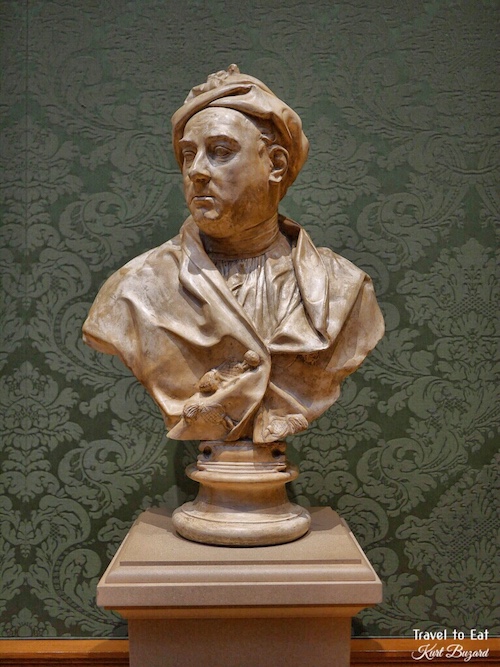
This painted plaster bust of the great German composer shows Handel (1685-1759) relaxed and dressed in casual attire: his soft cap jauntily leaning to one side and his house coat disheveled and partly unbuttoned, as he might have appeared to his friends at home in his study. Handel settled in London in 1712 where he composed such famous works as his Water Music and Messiah. Trained in Dresden and Paris, Roubiliac moved to London around 1730 where, in 1738, he created his first independent sculpture: the life-size seated sculpture of the same subject that was commissioned by entrepreneur Jonathan Tyers for the pleasure gardens at Vauxhall. Like the Huntington’s bust, the large-scale marble of Handel is an unusually informal rendering. Moreover, busts of individuals who were neither soldiers nor statesmen were rare in Britain at the time. By the 1740s, a remarkable group of similar portraits, many by Roubiliac himself, were produced that show men, including architects and physicians, withoutany professional attribute and attired as if they were at home. Perhaps these portraits were meant to emphasize the intellectualism and humanity of the subjects. The Huntington bust was probably contemporary with the marble Handel for Vauxhall (now in the Victoria and Albert Museum), when the sitter was in his early fifties.

The two jewels of the Huntington collection are “Blue Boy” by Thomas Gainsborough in 1770 and “Pinkie” by Thomas Lawrence in 1794. Perhaps Gainsborough’s most famous work, it is thought to be a portrait of Jonathan Buttall (1752–1805), the son of a wealthy hardware merchant, although this has never been proven. It is a historical costume study as well as a portrait: the youth in his 17th-century apparel is regarded as Gainsborough’s homage to Anthony van Dyck, and in particular is very close to Van Dyck’s portrait of Charles II as a boy. The Blue Boy was Gainsborough’s first attempt at full length Van Dyck dress – knee breeches and a slashed doublet with a lace collar – which is based on the work of Anthony van Dyck, the 17th-century Flemish painter who had revolutionized British art. The shimmering blue satin is rendered in a spectrum of minutely calibrated tints, indigo, lapis, cobalt, slate, turquoise, charcoal, and cream, which have been applied in extremely complex layers of vigorous slashes and fine strokes.
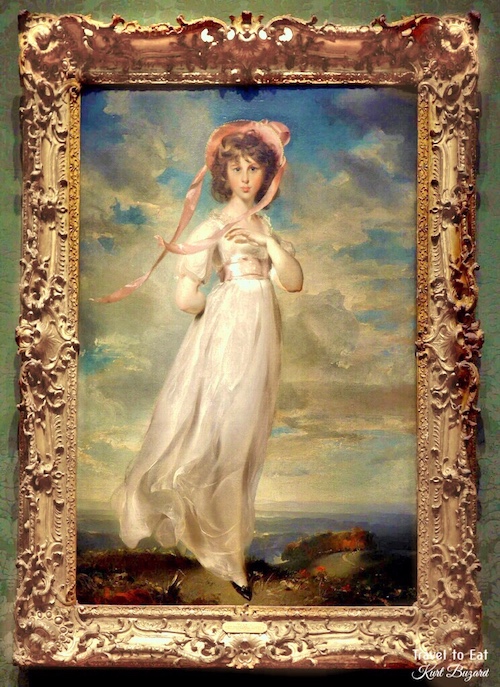
Judith Barrett commissioned this painting of her granddaughter to ease the pain of the child’s absence. Sarah, known to her family as “Pinkie,” was raised in the British colony of Jamaica before being sent to England for schooling. Mrs. Barrett requested that her granddaughter be depicted “in an easy, careless attitude.” Pinkies brilliant hat ribbons flutter in the breeze while a gust of wind picks up her lustrous while skirts. With her right arm bent behind her back, her left arm raised in front of her chest, and her right tor pointed, Pinkie appears ready to perform one of the sophisticated dance steps she would have recently learned, demonstrating for her grandmother the civilized refinements she was acquiring in England. Lawrence’s use of a low horizon heightens the monumentality of this portrait of a young girl, who died shortly after the painting was completed. His idealized portrayal of childhood led to “Pinkie’s” international fame and iconic status.
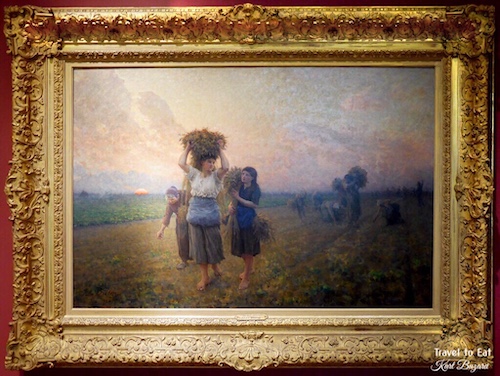
As you can tell, I am enchanted by this painting and the painter, Jules Adolphe Aime Louis Breton. Like other 19th-century French painters such as Gustave Courbet and Jean-Francois Millet, Breton was interested in themes of social realism. Many of his paintings, like this one, show peasants working in the fields. The sunset, as well as the activity of gleaning, the final gathering of remnants of wheat that marks the end of the harvest, can be seen as a metaphor for the passage of time. Bretons inclusion of a young girl, mature woman, and elderly gleaner reinforce this theme.

Of all of the surprising paintings at the Huntington, this is one of the best. I simply love Turner and this painting points the way to his later work. A city of light and water, Venice enabled Turner to indulge his fascination with brilliant effects of color and luminosity. More than a simple view of the famous city, the painting also offers associations which would have been familiar to English visitors. For example, in the right foreground, leaning out a window, the figure of Shylock from Shakespeare’s play “The Merchant of Venice” brandishes a document, a set of scales, and a knife; all references to his infamous demand of a pound of flesh in exchange for a loan. Turners image of Venice is of a fantastic dreamscape of plays and fables, where reflections on the water and shimmering highlights delight the eye.
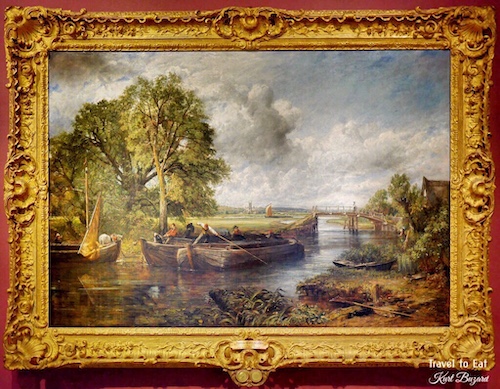

Through dress, stance, and expression Constable articulates the difference between his sisters. Mary, the younger sister, stands on the right, dressed in a delicate muslim gown and red riding hood. Her passive countenance stands out in contract to the purposeful appearance of her older sister, Ann,who stands on the left. Ann is dressed more starkly in a woman’s version of a masculine riding habit. An ivy vine, symbol of friendship and fidelity,links the figures and alludes to their mutual devotion. This sensitive portrait of family members demonstrates that although Constable distinguished himself as a landscape painter, he was capable of great psychological insight.

Since Antiquity, animals engaged in a life and death struggle has been a popular subject for sculpture. Carved in the round, the drama unfolds by way of a series of engaging viewpoints and silhouettes.The subject matter, rather than upsetting, served as a source of dramatic entertainment. Around the brutal attack, the artist has inserted engaging details such as tufts of foliage, a lizard, a snake, and a snail. This is a version of a sculpture by Franzoniin the Vatican’s Room of the Animal, the gallery that includes both fragmentary ancient marbles the artist restored as well as several of his original compositions, such as this one. If you are in Los Angeles, consider a visit to “The Huntington”, there a great deal to see and learn. Please take the time to leave a comment.
References:
The Huntington: http://www.huntington.org/
Shimmer Evening Primrose: http://davesgarden.com/guides/pf/go/149288/#b
Cape Rush: http://www.louistheplantgeek.com/a-gardening-journal/388-chondropetalum-elephantinum

